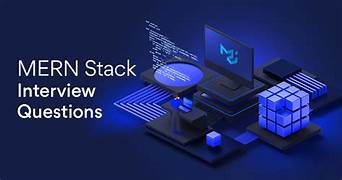Top 40 MERN Stack Interview Questions and Answers: Your Ultimate Guide to Success
The MERN stack—MongoDB, Express.js, React.js, and Node.js—is one of the most in-demand tech stacks in modern web development. If you’re aiming to land a job as a MERN stack developer, being well-prepared for technical interviews is key.
Whether you’re a fresher or an experienced developer brushing up your skills, this guide will walk you through the top 40 MERN stack interview questions and answers you need to ace your next job interview. We’ll cover all four technologies, along with real-world scenarios and interview tips.
🔹 Section 1: General MERN Stack Questions
1. What is the MERN Stack?
The MERN stack is a set of JavaScript-based technologies used to build full-stack web applications. It includes:
- MongoDB (database),
- Express.js (backend framework),
- React.js (frontend library),
- Node.js (server environment).
2. Why is MERN so popular?
MERN allows developers to use JavaScript throughout the stack, making development faster and more efficient. Plus, React’s component-based architecture makes UI development easier.
3. What’s the difference between MEAN and MERN?
MEAN uses Angular for the frontend, while MERN uses React. React is more flexible and easier to integrate with other tools.
🔹 Section 2: MongoDB Questions
4. What is MongoDB?
MongoDB is a NoSQL database that stores data in JSON-like documents called BSON (Binary JSON). It’s schema-less and highly scalable.
5. What is a document in MongoDB?
A document is a key-value pair structure similar to JSON. For example:
{
"name": "Alice",
"age": 28,
"skills": ["React", "Node"]
}
6. What is a collection in MongoDB?
A collection is a group of MongoDB documents—similar to a table in SQL databases.
7. How do you query data in MongoDB?
Using methods like find() and findOne():
db.users.find({ age: { $gt: 25 } });
8. What are indexes in MongoDB?
Indexes improve query performance. You can create them using:
db.users.createIndex({ name: 1 });
9. What’s the difference between embedded and referenced documents?
- Embedded: Nested documents stored in one document (faster read).
- Referenced: Separate documents with links (better for large data).
10. What is Mongoose?
Mongoose is an ODM (Object Data Modeling) library for MongoDB and Node.js. It simplifies schema design and data validation.
🔹 Section 3: Express.js Questions
11. What is Express.js?
Express is a minimalist web framework for Node.js that simplifies building backend APIs and handling HTTP requests.
12. How do you create a basic Express server?
const express = require('express');
const app = express();
app.get('/', (req, res) => res.send('Hello World!'));
app.listen(3000, () => console.log('Server running'));
13. What is middleware in Express?
Middleware is a function that processes requests before they reach the endpoint. For example:
app.use(express.json()); // parses JSON bodies
14. How do you handle errors in Express?
Using error-handling middleware:
app.use((err, req, res, next) => {
res.status(500).send('Something went wrong');
});
15. What are routes in Express?
Routes define how the server responds to client requests:
app.post('/user', (req, res) => { /* logic */ });
16. How do you connect MongoDB with Express?
Using Mongoose:
const mongoose = require('mongoose');
mongoose.connect('mongodb://localhost/mydb');
🔹 Section 4: React.js Questions
17. What is React?
React is a JavaScript library used to build dynamic user interfaces using reusable components.
18. What is JSX?
JSX stands for JavaScript XML. It allows writing HTML-like code in React:
const element = <h1>Hello, React!</h1>;
19. What are props in React?
Props (short for “properties”) are used to pass data from parent to child components.
20. What is state in React?
State is a built-in object used to track dynamic data in a component.
21. What is the difference between class and functional components?
- Class components: Use lifecycle methods and
this.state. - Functional components: Use hooks like
useStateanduseEffect.
22. What is a hook in React?
Hooks are functions that let you use React features in functional components. Example:
const [count, setCount] = useState(0);
23. What does useEffect do?
useEffect is used for side effects like fetching data, subscribing to events, etc.
24. What is conditional rendering?
Rendering components or elements based on conditions:
{isLoggedIn ? <Dashboard /> : <Login />}
25. How do you fetch data in React?
Using fetch or libraries like axios:
useEffect(() => {
fetch('/api/data')
.then(res => res.json())
.then(setData);
}, []);
🔹 Section 5: Node.js Questions
26. What is Node.js?
Node.js is a runtime environment that allows JavaScript to be executed on the server.
27. What is the event loop in Node.js?
It’s the core mechanism that handles asynchronous operations in a non-blocking way.
28. What are callbacks?
Functions passed as arguments that are executed after another function completes:
fs.readFile('file.txt', (err, data) => {
console.log(data);
});
29. What are Promises?
Promises represent a value that will be available in the future:
fetch('/api').then(res => res.json()).then(data => console.log(data));
30. What is async/await?
A cleaner way to write asynchronous code:
const data = await fetchData();
31. How do you handle file uploads in Node.js?
Using packages like multer for handling multipart/form-data.
32. How do you secure your Node.js application?
- Use environment variables
- Validate input
- Sanitize database queries
- Implement authentication and authorization
🔹 Section 6: Full Stack & Integration
33. How does the MERN stack work together?
- React handles UI
- Express/Node handles API and logic
- MongoDB stores data They communicate using RESTful APIs or GraphQL.
34. How do you create a REST API in MERN?
Create routes in Express, connect them to MongoDB using Mongoose, and call them from React using fetch or axios.
35. How do you handle CORS in MERN?
Use the cors middleware in Express:
const cors = require('cors');
app.use(cors());
36. How do you implement authentication in MERN?
Use:
- JWT (JSON Web Token) for token-based authentication
bcryptfor hashing passwords
37. How do you manage sessions or tokens in the frontend?
Store tokens in localStorage or sessionStorage and attach them to API requests.
38. How do you deploy a MERN app?
Use platforms like:
- Frontend: Netlify, Vercel
- Backend: Render, Heroku, Railway
- Or deploy full stack using Docker or AWS
🔹 Section 7: Behavioral & Real-World Questions
39. Tell me about a project you built using MERN.
Talk about the problem, the tech stack, challenges faced, and what you learned. Highlight full-stack thinking and teamwork.
40. What challenges have you faced working with MERN and how did you solve them?
Mention real-world issues like API latency, CORS errors, state management challenges, or database design issues—and your solutions.
💡 Pro Interview Tips
- Build a sample project before your interview. A CRUD app (like a to-do list or blog) is perfect.
- Understand the flow of requests from React to Express to MongoDB and back.
- Read documentation, especially for React hooks and Mongoose.
- Practice writing code without autocomplete. Many interviews are on whiteboards or coding platforms.
- Ask questions during interviews—it shows curiosity and maturity.
✅ Final Thoughts
The MERN stack is powerful, flexible, and job-friendly. Mastering it doesn’t just make you a full-stack developer—it makes you a complete developer.
With this list of 40 questions and answers, you now have a solid foundation to face any MERN stack interview with confidence. Keep practicing, keep building, and you’ll be unstoppable.


